Page 3

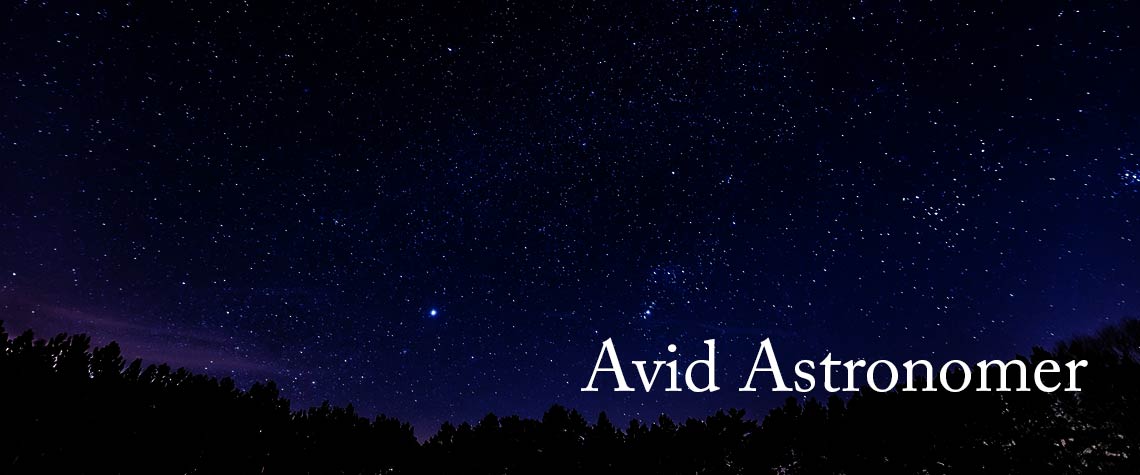
Member Spotlight - Tom Campbell
Tom Campbell, an avid astronomer, can be seen on almost any clear night peering through his telescope, looking into the heavens for the brightest or the faintest celestial objects.
1. Tell us about yourself.
I'm a native Kansan, where I lived in various small towns building a career as both a computer technician and software developer. The small town dark skies were great, but career potential was small. My last job there was working as a computer tech for a community college, where they also let me teach an online introductory astronomy course for several years.
In 2014, I found a good opportunity in Lubbock, Texas, so I took it, and my wife and I began building a new life there. The West Texas desert offered many days with clear skies, but the transparency was usually terrible due to blowing dust.
However, in 2015, I was offered a job that I couldn't pass up at TEEX, so we moved again. By day, I'm a software developer writing custom code for online courses. By night, I have several interests, but my main hobby is amateur astronomy.
In 2014, I applied for and was selected to become a NASA/JPL Solar System Ambassador. I am one of about 700 people in the United States and its territories with this honor. Being an SSA is purely voluntary. I receive no money from NASA and can never accept money or rewards for representing NASA.
But the perks include getting to attend teleconferences with actual engineers working on NASA or JPL missions. For me, the joy of seeing a kid's face light up when I hand him a NASA sticker is worth more than money.
I also enjoy singing, but haven't had the chance to do much of that since moving to Texas. I prefer singing in a group or chorus instead of solo, but I did enjoy being in a barbershop quartet for several years.
Other hobbies and interests include web page design, robotics, and writing science-fiction and astronomy-based short stories and poetry.
2. How did you become interested in astronomy?
One of my earliest memories was watching the manned moon landings on my parents' black and white television. I was only 3-4 years old at the time, but I have vivid memories of dropping my toys and watching TV whenever the news came on and started talking about the astronauts. I've never grown tired of looking up at the night sky.
In junior high school, I saved my allowance to buy my first telescope. It was nothing but a 30x30 spyglass, but it showed me craters on the Moon and I was hooked. Nearly 40 years later, I still have this tiny telescope in my collection.
3. What type of equipment do you currently use for observations?
My most-used telescope is my Zhumell Z12, a 12-inch Dobsonian reflector. I've nicknamed it "Zoomie" as a play on words between the brand name and how much I can see with it. I have a wide assortment of eyepieces I've collected over the years, but my current favorites are my 82° Explore Scientifics and my Celestron 2.5x barlow. Most nights, I use nothing but those.
Also, I never go observing without my observing chair. With one bad knee, I find that helps me to be able to relax and concentrate more on what I'm seeing than on how to stop my feet and legs from hurting. It cost about as much as a decent eyepiece, but it is the best accessory I have ever purchased.
When traveling, I have an 80mm short tube refractor (I named it "Cutie") that easily fits inside a backpack and offers incredible widefield views.
4. Describe a normal night of observing?
A little before sunset, I will look at the sky conditions and if the weather is promising, I will haul my telescope and gear to the back yard to cool down. While it is still daylight, I will check the collimation with my laser collimator and adjust the mirrors if necessary. I will also verify that my finderscope and Telrad are properly aligned by aiming at a distant terrestrial object.
Then I will go back inside and print out an observing list and any finder charts I need for a particularly hard to find target. I typically use a freeware program called Stellarium to print my finder charts.
Once it gets nice and dark, I'll head back outside to do my observing. I usually have my observing list sorted in order by constellation, so I don't have to swing the telescope back and forth across the sky.
Before starting on the list, I will scan the sky with my unaided eye and see if any planets or other favorite objects are up. I will look at two or three of them just to see how the sky conditions will affect my viewing of the objects on my list.
To find an object, I will use the Telrad unit finder to get to a nearby naked eye star. The Telrad projects a bullseye pattern on the sky when you look through it. You just move the telescope until the star you want is right in the center of the bullseye.
Once this is done, I will "starhop" to the object by using my 8x50 finderscope. The number of stars I can see through my finderscope matches pretty closely to my Pocket Sky Atlas, so it is easy to match patterns of stars to nudge the telescope into the right spot.
At this point, the object is usually centered in the eyepiece, so I will pull out my smartphone voice recorder app and describe what I see. After I'm done observing (usually the next day), I will transcribe those notes into a StarLog observing report.
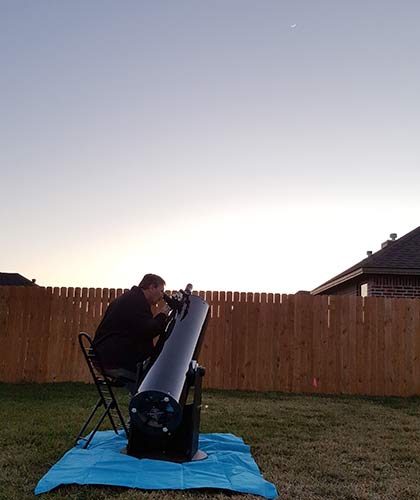
Tom Campbell observes the moon during an observation exercise.
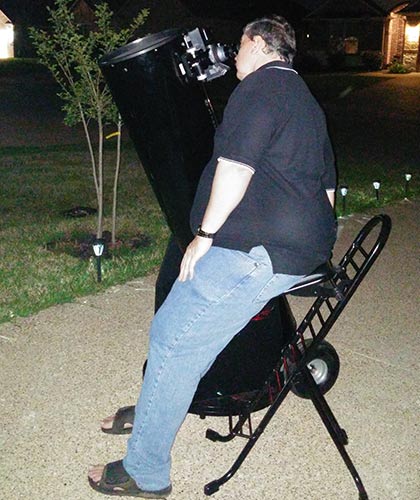
Tom Campbell settles in for a night of observing with his Dobsonian.
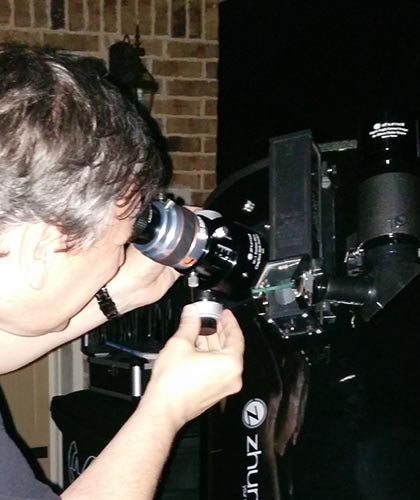
Tom surveys the night sky, looking for objects on his observing list.
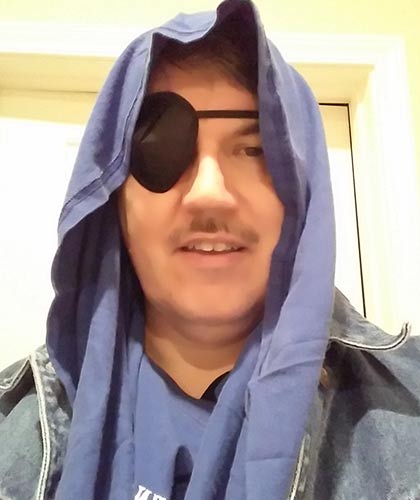
Tom wears the eye patch to get his observing eye dark adapted while waiting for sunset, and he wears the T-shirt over his head to act as a hood to block out stray light from neighborhood porch lights.
5. Do you have a favorite area of the sky and favorite time of the year to observe? Why?
It's hard to say. I have favorite constellations for every season. In the Winter, Orion has lots of great nebulas and double stars. In Spring, Virgo is chock-full of galaxies and Hercules has a few great globular clusters. In Summer, Sagittarius and Scorpius provide an almost endless array of bright celestial objects because they sit near the center of Milky Way. In Autumn, Auriga has some drop-dead gorgeous open clusters.
I don't really have a preference of one type of object over another, so I look at whatever happens to be up in the sky that night and enjoy the views.
6. What is the most awe-inspiring object or event you have seen through your telescope?
Wow, that's a tough question. There are so many. I distinctly remember the first time I saw craters on the Moon, the Galilean satellites orbiting Jupiter, the rings of Saturn and the billowing clouds of the Great Orion Nebula. I've viewed them hundreds of times, and they still take my breath away.
Then there are the transients. I remember following Comet Hale-Bopp for weeks. I remember seeing a bright meteor streak across the sky in the daytime. I've seen a star going nova in another galaxy. All of these are awe-inspiring.
If I had to choose just one, it would probably have to be the Moon. Simply because it is so nearby and we can see so much detail. However, like many astronomers, I have a love-hate relationship with the Moon. Its beauty can't be matched in the heavens, but at the same time, it is so bright that it washes out a lot of the fainter celestial objects that I'd also love to see.
7. Do you have any advice for beginners who are interested in the hobby?
Amateur astronomy is one of the few hobbies where you can pour as much or as little money as you want into it and still get a lifetime of enjoyment. Just sitting in a lawn chair in your back yard on a dark and clear night is amazing. For some of us, we yearn to see more and Hubble pictures in a magazine just don't satisfy. We want to see it with our own eyes.
For a beginner, I will often recommend a good pair of binoculars. You can run down to Wal-Mart and pick up a pair of 10x50 binoculars for less than $30 and they will open up a whole new world compared to viewing with the unaided eye. Nothing can beat the view of the Milky Way through binoculars. Or even the Pleiades. I guarantee if you're interested in stargazing at all, these sights will make your jaw drop.
Another advantage of binoculars is that if you later decide astronomy really isn't your thing, you're not out much money and you can use them for other things, like bird watching or sporting events.
If you find yourself in love with the hobby, I recommend checking out a local astronomy club and comparing views through different telescopes. There is no such thing as a perfect telescope - they all have advantages and disadvantages. By looking through different kinds, you can figure out which one will work the best for what you want it to do.
BVAC is great in that after every meeting (weather permitting), a few members will set up various telescopes so that other members and visitors can look through them and get a feel for their strengths and weaknesses.
8. What gives you the most satisfaction with your hobby?
Whenever I sit down next to my telescope and start observing, I instantly feel relaxed. All my cares and worries are gone and I'm lost in the awe-inspiring wonder of our Universe. There are times when I've felt so relaxed, I just wanted to throw out a blanket on the ground and sleep under the stars.
But nice and peaceful as that is, I also have a desire within me to want to share my hobby with the world. I'm normally pretty quiet and shy around people I don't know, but if someone comes up to me and wants to take a look through my telescope, I open up and try to share my passion with him or her.
Some amateur astronomers are very cautious about letting other people touch or use their telescopes and equipment. I completely understand that. I'm not rich by any means, but even I have thousands of dollars invested in my astronomy equipment. Seeing a 5-year-old with pizza in one hand and a drink sloshing out of his cup in the other come running up to look through your telescope can be daunting. You immediately play through a hundred scenarios in your mind and most of them end up with gooey cheese all over your eyepieces and coke splashed on your mirrors or lenses.
Outreach isn't for everyone. But it is wonderful for me. Hearing a child ask me a hundred questions per minute about space and telescopes thrills me. I can see that passion in their eyes and it's the same passion that's within me. It rekindles that fire deep in my belly and I am transported back in time to when I was their age and how wonderful it would have been to have someone share their telescope with me.
And it's not just the kids. I enjoy seeing an adult look through the eyepiece at Saturn's rings and say, "Wow!" Then they will glance up at the sky to the pale yellow dot gleaming in the night and look through the telescope once again to make sure they're really seeing what they think they see.
To me, that's more than worth the effort of cleaning cheese pizza off my eyepieces. Of course, I never use my best eyepieces during an outreach event, but I don't use my cheapest, either. I want to leave them with a view worth remembering.
